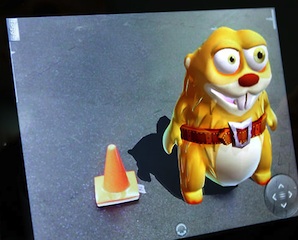Six slick technologies re-shaping the future

A few weeks ago, I went to the annual Defrag conference in Broomfield, Colo., to check in on a few identity related tracks and while I was there the future broke out in the form of the Blur Conference.
What I found was a glimpse of the future in gaming, touch-sensitive phone cases, multi-touch tables, viable consumer market 3D printers and thought-controlled apps. They would all make smile-enducing entries on any holiday shopping list.
Sphero:

This little robotic ball rolled onto the scene a few years ago is now moving into augmented reality (AR) games with the introduction of Sharky the Beaver. The 3-D cupcake eating Beaver looks to be moving through your real-world surroundings as you control the animal from your tablet or smartphone. (see him in action).
The Sphero ball acts as the AR marker, which allows Sharky to enter your physical world. Sphero has an API and an SDK so developers can add to the fun. As the company says, it’s not just a ball.
Sphero Glider:
Just to give an idea what the API and SDK can do, two developers have come up with a mobile flying game that incorporates real gliding physics and uses Sphero as the game controller. The robotic controls in the ball give the game a life-like feel. Developer brothers Casey and Skylar Graika quit their jobs at Boeing, began a Kickstarter program, and are taking a flier (no pun intended) on becoming mobile game kingpins. Their first effort is modeled on Pilotwings 64 and runs on iOS and Android devices. The proto-type has been in testing for two months, said Casey.
Sensus:
Canopy has come up with a touch sensitive mobile phone case that includes dual micro sensors for gesture and recognition, according to marketing coordinator Ian Spinelli. What does that mean? Instead of touching the screen, the touch navigation happens on the back of the device. The proto-type includes a drawing app and more apps are on the way. Sensus adds a row of graphical buttons to the phone interface and comes with a free developers kit to light them up with logic.
Touch Table
Ideum showed off its elegant multi-touch tables with a 55-inch screen and some simple applications built with the company’s Gesture Works gesture-based development environment. The firm has been building these tables since 2008 with the goal of creating a user-centric experience that uses visual queues to direct users instead of traditional menus, said company CTO Paul Lacey. They can be used as home accessories, wall mounted monitors and in museum settings. See this video showing an exhibit at the Penn Museum supported by a multitouch table.
MakerBot. Printrbot.
Mainstream (and affordable) 3D printing is reality and you could use it to print out your holiday decorations. Or whatever strikes your fancy. These amazing machines print physical objects layer by layer. “People at NASA are prototyping their prototypes with MakerBot,” said CEO Bre Pettis. “We are living in the best time to be creative.” In October the company started shipping its Replicator 2 Desktop 3D Printer. In the same vein but with a more affordable entry price, PrintrBot has hit the market with a line of 3D printers, including the Printrbot jr. ($399), Printrbot LC, Printrbot Plus and Printerbot GO, which comes with its own airline-worthy carrying case. Founder Brook Drumm is living his mantra that 3D printers should be affordable.
Shapeways
If you’re not interested in buying a 3D printer and printing your own items, Shapeways is the next best thing. The commercial printer is a sort of crowd-sourced retail outlet for 3D printed stuff. People can make, buy, and sell their own products printed in stainless steel, sterling silver, ceramic, plastic, sandstone and a number of other materials used as a foundation or a finish. In 2012 alone, Shapeways printed over a million products. “3D printing is the future of stuff,” says Charlie Maddock, director of business development at Shapeways. “Mass produced items are boring." Independent designer David Bush was at the Blur conference and said he got started by buying a $129 3D modeling program to design mini-sculptures, including Gear Heart, which won first prize in Shapeway's Maker Faire content in 2009. The design was a tribute to papercraft artist Haruki Nakamura's sculpture, Gear's Heart.
InteraXon
Thought-controlled computing is coming to the mass market this summer in the form of InteraXon’s Muse headband. Slip it on and fire up apps that let your brain control video game play, or workout with brain fitness apps that improve attention span and increase working memory.
“Current brain games build your brain like carrying groceries in from the car,” says company CEO Ariel Garten. “This builds your brain like doing bench press reps in the gym.” (Listen to her Ted Talk).
Muse, which talks to devices via Bluetooth, is an electroencephalograph (EEG) that records brainwaves and reads the brain's overall pattern of activity to detect certain states such as relaxed or alert. The output is converted to ones and zeros used to control anything electric.